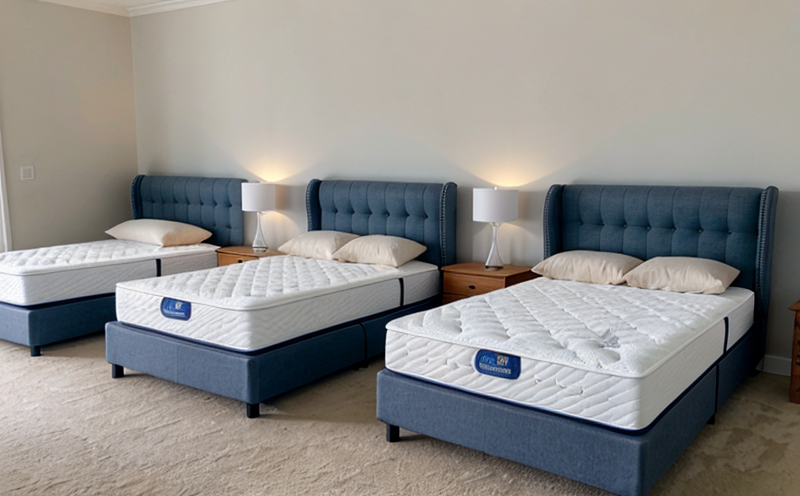BS EN 12951 Bunk Beds and High Beds Mechanical Durability Testing
The British Standard (BS) EN 12951 specifies the requirements for mechanical durability testing of bunk beds and high beds. This test is crucial to ensure that these types of furniture meet stringent safety standards, especially in environments where they are subjected to repeated use and stress.
Bunk beds and high beds are common fixtures in numerous settings, from shared dormitories to home bedrooms. The mechanical durability test under BS EN 12951 aims to verify the structural integrity and stability of these beds over extended periods. This ensures that consumers can rely on them for years without compromising their safety.
The standard covers various aspects of bunk bed and high bed design, including but not limited to:
- Structural components such as posts, rails, and slats
- Mechanical connections like screws and bolts
- Adjustability features for beds
- Stability under different loading conditions
The testing protocol involves applying a series of load cycles to replicate real-world usage scenarios. This includes static loads, dynamic loads, and occasional overloads that the bed might encounter.
For bunk beds specifically, the test focuses on the lower sleeping platform as well as the ladder or steps leading up to it. The standard also considers the impact of children climbing onto and using these beds. High beds are tested for their upper sleeping platforms, ensuring they can withstand the weight and pressure exerted by adults.
Compliance with BS EN 12951 is essential not only for manufacturers but also for retailers to maintain a good reputation in the market. Consumers expect safe products that meet international standards, and failing these tests could result in product recalls or legal actions. Therefore, it’s crucial for quality managers and compliance officers to ensure their products undergo this testing.
R&D engineers play a vital role in designing bunk beds and high beds that can withstand rigorous mechanical durability testing. By incorporating advanced materials and innovative designs, they can enhance the performance of these beds while meeting regulatory requirements.
For procurement teams, it is equally important to source materials and components that meet the stringent criteria outlined in BS EN 12951. This ensures that all parts contribute to the overall durability and safety of the final product.
The testing process typically involves several steps:
Preparation of the specimen bed according to the standard's specifications
Application of static loads to simulate normal use conditions
Application of dynamic loads to replicate real-world movements and stresses
Subjecting the bed to occasional overloads to test its robustness
Evaluation of the bed's structural integrity post-testing
The results are documented comprehensively, detailing any issues encountered during testing. This report is then used by manufacturers and designers to make necessary adjustments and improvements.
Understanding the full scope of BS EN 12951 ensures that all stakeholders involved in the production and sale of bunk beds and high beds can meet regulatory requirements effectively.
Industry Applications
| Application Area | Description |
|---|---|
| Dormitory Furniture | Bunk beds are often used in student dormitories to maximize space while providing comfortable sleeping arrangements. |
| Homes with Multiple Bedrooms | In homes where multiple children or adults share bedrooms, bunk beds offer a practical solution for efficient use of space. |
| Shared Housing Facilities | Beds in shared housing units must be durable and safe to ensure the comfort and security of all occupants. |
| Childcare Centers | Safety is paramount in childcare centers, making mechanical durability tests essential for ensuring bunk beds used are robust enough to withstand frequent use. |
Bunk beds and high beds tested according to BS EN 12951 find applications in various settings where multiple users share sleeping space. Their mechanical durability ensures they can endure the stresses of daily use, whether in a dormitory setting or a shared home environment.
Why Choose This Test
To ensure compliance with international safety standards and regulations
To enhance the durability of bunk beds and high beds for longer use in challenging environments
To protect consumers by ensuring safe products are available on the market
To provide manufacturers with valuable data for improving product designs and materials
To reduce the risk of product recalls due to structural failures or injuries caused by unsafe beds
Choosing BS EN 12951 mechanical durability testing ensures that bunk beds and high beds are thoroughly evaluated, providing peace of mind for all stakeholders involved in their production and use.
Environmental and Sustainability Contributions
Reduces waste by ensuring that bunk beds remain structurally sound over extended periods, allowing them to be reused rather than discarded after a short period of use.
Promotes the use of sustainable materials in bed construction, encouraging manufacturers to source eco-friendly options for their products.
Encourages efficient use of space, as bunk beds allow multiple users to share sleeping quarters, reducing overall demand on resources and energy consumption.
The mechanical durability testing under BS EN 12951 supports environmental sustainability by promoting the longevity and reliability of bunk beds, thereby reducing waste and encouraging responsible manufacturing practices.





